Increasing the Thematic Resolution for Trees and Built Area in a Global Land Cover Dataset Using Class Probabilities
Abstract
1. Introduction
2. Materials and Methods
2.1. Site Design
2.2. Land Cover Data
2.3. Subclassification
2.3.1. Probability Thresholds
2.3.2. Transformations
2.4. Transferability, Temporal, and Human-Classified Validations
2.4.1. Transferability Evaluation
2.4.2. Temporal Variability Analysis
2.4.3. Human-Classified Validations
3. Results
3.1. Subclassifications for Temperate Forest, Tropical Forest, and Developed Land
3.2. Evaluation of Transferability and Human-Classified Reference
4. Discussion
Limitations of the Study
5. Conclusions
Supplementary Materials
Author Contributions
Funding
Data Availability Statement
Acknowledgments
Conflicts of Interest
Abbreviations
| CNN | Convolutional Neural Network |
| ESA | European Space Agency |
| NLCD | National Land Cover Database |
| ESRI | Environmental Systems Research Institute, Inc. |
| SINAC | National System of Conservation Areas |
| OA | Overall accuracy |
References
- Akkermans, T.; Van Rompaey, A.; Van Lipzig, N.; Moonen, P.; Verbist, B. Quantifying Successional Land Cover after Clearing of Tropical Rainforest along Forest Frontiers in the Congo Basin. Phys. Geogr. 2013, 34, 417–440. [Google Scholar] [CrossRef]
- Duan, Y.; Akula, S.; Kumar, S.; Lee, W.; Khajehei, S. A Hybrid Physics–AI Model to Improve Hydrological Forecasts. Artif. Intell. Earth Syst. 2023, 2, e220023. [Google Scholar] [CrossRef]
- Fu, B.; Merritt, W.S.; Croke, B.F.W.; Weber, T.R.; Jakeman, A.J. A Review of Catchment-Scale Water Quality and Erosion Models and a Synthesis of Future Prospects. Environ. Model. Softw. 2019, 114, 75–97. [Google Scholar] [CrossRef]
- Massoud, E.C.; Hoffman, F.; Shi, Z.; Tang, J.; Alhajjar, E.; Barnes, M.; Braghiere, R.K.; Cardon, Z.; Collier, N.; Crompton, O.; et al. Perspectives on Artificial Intelligence for Predictions in Ecohydrology. Artif. Intell. Earth Syst. 2023, 2, e230005. [Google Scholar] [CrossRef]
- Yao, S.; Chen, C.; He, M.; Cui, Z.; Mo, K.; Pang, R.; Chen, Q. Land Use as an Important Indicator for Water Quality Prediction in a Region under Rapid Urbanization. Ecol. Indic. 2023, 146, 109768. [Google Scholar] [CrossRef]
- Arnold, J.G.; Srinivasan, R.; Muttiah, R.S.; Williams, J.R. Large Area Hydrologic Modeling and Assessment Part I: Model Development. JAWRA J. Am. Water Resour. Assoc. 1998, 34, 73–89. [Google Scholar] [CrossRef]
- Haith, D.A.; Shoemaker, L.L. Generalized Watershed Loading Functions for Stream Flow Nutrients. JAWRA J. Am. Water Resour. Assoc. 1987, 23, 471–478. [Google Scholar] [CrossRef]
- Yang, L.; Jin, S.; Danielson, P.; Homer, C.; Gass, L.; Bender, S.M.; Case, A.; Costello, C.; Dewitz, J.; Fry, J.; et al. A New Generation of the United States National Land Cover Database: Requirements, Research Priorities, Design, and Implementation Strategies. ISPRS J. Photogramm. Remote Sens. 2018, 146, 108–123. [Google Scholar] [CrossRef]
- Boryan, C.; Yang, Z.; Mueller, R.; Craig, M. Monitoring US Agriculture: The US Department of Agriculture, National Agricultural Statistics Service, Cropland Data Layer Program. Geocarto Int. 2011, 26, 341–358. [Google Scholar] [CrossRef]
- Liang, S.; He, T.; Huang, J.; Jia, A.; Zhang, Y.; Cao, Y.; Chen, X.; Chen, X.; Cheng, J.; Jiang, B. Advances in High-Resolution Land Surface Satellite Products: A Comprehensive Review of Inversion Algorithms, Products and Challenges. Sci. Remote Sens. 2024, 10, 100152. [Google Scholar] [CrossRef]
- Xu, P.; Tsendbazar, N.-E.; Herold, M.; de Bruin, S.; Koopmans, M.; Birch, T.; Carter, S.; Fritz, S.; Lesiv, M.; Mazur, E. Comparative Validation of Recent 10 M-Resolution Global Land Cover Maps. Remote Sens. Env. 2024, 311, 114316. [Google Scholar] [CrossRef]
- Zanaga, D.; Van De Kerchove, R.; Daems, D.; De Keersmaecker, W.; Brockmann, C.; Kirches, G.; Wevers, J.; Cartus, O.; Santoro, M.; Fritz, S. ESA WorldCover 10 m 2021 V200, Version v200; ESA: Paris, France, 2022. [Google Scholar] [CrossRef]
- Zanaga, D.; Van De Kerchove, R.; De Keersmaecker, W.; Souverijns, N.; Brockmann, C.; Quast, R.; Wevers, J.; Grosu, A.; Paccini, A.; Vergnaud, S.; et al. ESA WorldCover 10 m 2020 V100, Version V100; ESA: Paris, France, 2022. [Google Scholar]
- Auerbach, D.A.; Buchanan, B.P.; Alexiades, A.V.; Anderson, E.P.; Encalada, A.C.; Larson, E.I.; McManamay, R.A.; Poe, G.L.; Walter, M.T.; Flecker, A.S. Towards Catchment Classification in Data-Scarce Regions. Ecohydrology 2016, 9, 1235–1247. [Google Scholar] [CrossRef]
- de Lima, R.A.F.; Phillips, O.L.; Duque, A.; Tello, J.S.; Davies, S.J.; de Oliveira, A.A.; Muller, S.; Honorio Coronado, E.N.; Vilanova, E.; Cuni-Sanchez, A.; et al. Making Forest Data Fair and Open. Nat. Ecol. Evol. 2022, 6, 656–658. [Google Scholar] [CrossRef] [PubMed]
- Pandeya, B.; Buytaert, W.; Zulkafli, Z.; Karpouzoglou, T.; Mao, F.; Hannah, D.M. A Comparative Analysis of Ecosystem Services Valuation Approaches for Application at the Local Scale and in Data Scarce Regions. Ecosyst. Serv. 2016, 22, 250–259. [Google Scholar] [CrossRef]
- Wagner, P.D.; Fiener, P.; Wilken, F.; Kumar, S.; Schneider, K. Comparison and Evaluation of Spatial Interpolation Schemes for Daily Rainfall in Data Scarce Regions. J. Hydrol. 2012, 464–465, 388–400. [Google Scholar] [CrossRef]
- Stanimirova, R.; Tarrio, K.; Turlej, K.; McAvoy, K.; Stonebrook, S.; Hu, K.-T.; Arévalo, P.; Bullock, E.L.; Zhang, Y.; Woodcock, C.E.; et al. A Global Land Cover Training Dataset from 1984 to 2020. Sci. Data 2023, 10, 879. [Google Scholar] [CrossRef] [PubMed]
- Zhang, H.K.; Roy, D.P.; Luo, D. Demonstration of Large Area Land Cover Classification with a One Dimensional Convolutional Neural Network Applied to Single Pixel Temporal Metric Percentiles. Remote Sens. Environ. 2023, 295, 113653. [Google Scholar] [CrossRef]
- Kolarik, N.E.; Roopsind, A.; Pickens, A.; Brandt, J.S. A Satellite-Based Monitoring System for Quantifying Surface Water and Mesic Vegetation Dynamics in a Semi-Arid Region. Ecol. Indic. 2023, 147, 109965. [Google Scholar] [CrossRef]
- Cardille, J.A.; Fortin, J.A. Bayesian Updating of Land-Cover Estimates in a Data-Rich Environment. Remote Sens. Environ. 2016, 186, 234–249. [Google Scholar] [CrossRef]
- Pasquarella, V.J.; Arévalo, P.; Bratley, K.H.; Bullock, E.L.; Gorelick, N.; Yang, Z.; Kennedy, R.E. Demystifying LandTrendr and CCDC Temporal Segmentation. Int. J. Appl. Earth Obs. Geoinf. 2022, 110, 102806. [Google Scholar] [CrossRef]
- Brown, C.F.; Brumby, S.P.; Guzder-Williams, B.; Birch, T.; Hyde, S.B.; Mazzariello, J.; Czerwinski, W.; Pasquarella, V.J.; Haertel, R.; Ilyushchenko, S.; et al. Dynamic World, Near Real-Time Global 10 m Land Use Land Cover Mapping. Sci. Data 2022, 9, 251. [Google Scholar] [CrossRef]
- Venter, Z.S.; Barton, D.N.; Chakraborty, T.; Simensen, T.; Singh, G. Global 10 m Land Use Land Cover Datasets: A Comparison of Dynamic World, World Cover and Esri Land Cover. Remote Sens. 2022, 14, 4101. [Google Scholar] [CrossRef]
- Sales, M.H.R.; De Bruin, S.; Souza, C.; Herold, M. Land Use and Land Cover Area Estimates from Class Membership Probability of a Random Forest Classification. IEEE Trans. Geosci. Remote Sens. 2021, 60, 4402711. [Google Scholar] [CrossRef]
- Wang, X.; Zhang, Y.; Zhang, K. Automatic 10 m Forest Cover Mapping in 2020 at China’s Han River Basin by Fusing ESA Sentinel-1/Sentinel-2 Land Cover and Sentinel-2 near Real-Time Forest Cover Possibility. Forests 2023, 14, 1133. [Google Scholar] [CrossRef]
- Boucher, A.; Seto, K.C.; Journel, A.G. A Novel Method for Mapping Land Cover Changes: Incorporating Time and Space with Geostatistics. IEEE Trans. Geosci. Remote Sens. 2006, 44, 3427–3435. [Google Scholar] [CrossRef]
- Khatami, R.; Mountrakis, G.; Stehman, S.V. Predicting Individual Pixel Error in Remote Sensing Soft Classification. Remote Sens. Environ. 2017, 199, 401–414. [Google Scholar] [CrossRef]
- Small, C.; Sousa, D. Spectral Characteristics of the Dynamic World Land Cover Classification. Remote Sens. 2023, 15, 575. [Google Scholar] [CrossRef]
- Venter, Z.S.; Roos, R.E.; Nowell, M.S.; Rusch, G.M.; Kvifte, G.M.; Sydenham, M.A.K. Comparing Global Sentinel-2 Land Cover Maps for Regional Species Distribution Modeling. Remote Sens. 2023, 15, 1749. [Google Scholar] [CrossRef]
- Zhang, W.; Wang, J.; Lin, H.; Cong, M.; Wan, Y.; Zhang, J. Fusing Multiple Land Cover Products Based on Locally Estimated Map-Reference Cover Type Transition Probabilities. Remote Sens. 2023, 15, 481. [Google Scholar] [CrossRef]
- Eliades, M.; Neophytides, S.; Mavrovouniotis, M.; Panagiotou, C.F.; Anastasiadou, M.N.; Varvaris, I.; Papoutsa, C.; Bachofer, F.; Michaelides, S.; Hadjimitsis, D. Temporal Dynamics of Global Barren Areas between 2001 and 2022 Derived from MODIS Land Cover Products. Remote Sens. 2024, 16, 3317. [Google Scholar] [CrossRef]
- Boston, T.; Van Dijk, A.; Thackway, R. Convolutional Neural Network Shows Greater Spatial and Temporal Stability in Multi-Annual Land Cover Mapping Than Pixel-Based Methods. Remote Sens. 2023, 15, 2132. [Google Scholar] [CrossRef]
- Ramachandra, T.V.; Negi, P.; Mondal, T.; Ahmed, S.A. Insights into the Linkages of Forest Structure Dynamics with Ecosystem Services. Sci. Rep. 2025, 15, 15606. [Google Scholar] [CrossRef] [PubMed]
- Deng, Y.; Chen, G.; Tang, B.; Duan, X.; Zuo, L.; Zhao, H. Study on Class Imbalance in Land Use Classification for Soil Erosion in Dry–Hot Valley Regions. Remote Sens. 2025, 17, 1628. [Google Scholar] [CrossRef]
- USGS GAP. Protected Areas Database of the United States (PAD-US) 3.0 (Ver. 2.0, March 2023); USGS: Reston, VA, USA, 2022. [Google Scholar] [CrossRef]
- Google. Google Satellite Basemap for South Fork Quantico Creek Watershed, Rock Creek Watershed, Bush Creek Watershed, Guanacaste National Park, and Western Hemisphere. Available online: https://developers.google.com/maps/documentation/javascript/maptypes (accessed on 2 June 2023).
- Ebrahimy, H.; Mirbagheri, B.; Matkan, A.A.; Azadbakht, M. Per-Pixel Land Cover Accuracy Prediction: A Random Forest-Based Method with Limited Reference Sample Data. ISPRS J. Photogramm. Remote Sens. 2021, 172, 17–27. [Google Scholar] [CrossRef]
- SINAC. Mature, Deciduous, and Secondary Forest; Costa Rica National System of Conservation Areas; SINAC: San José, Costa Rica, 2019. https://www.snitcr.go.cr/ico_servicios_ogc_info?k=bm9kbzo6NDA=&nombre=SINAC (accessed on 23 July 2025).
- Tait, A.M.; Brumby, S.P.; Hyde, S.B.; Mazzariello, J.; Corcoran, M. Dynamic World Training Dataset for Global Land Use and Land Cover Categorization of Satellite Imagery [Dataset]. PANGAEA 2021, 933475. [Google Scholar] [CrossRef]
- Bhosle, K.; Musande, V. Evaluation of Deep Learning CNN Model for Land Use Land Cover Classification and Crop Identification Using Hyperspectral Remote Sensing Images. J. Indian Soc. Remote Sens. 2019, 47, 1949–1958. [Google Scholar] [CrossRef]
- Zhang, F.; Yan, M.; Hu, C.; Ni, J.; Zhou, Y. Integrating Coordinate Features in CNN-Based Remote Sensing Imagery Classification. IEEE Geosci. Remote Sens. Lett. 2021, 19, 5502505. [Google Scholar] [CrossRef]
- Brown, C. Google/Dynamicworld: V1.0.0, Version 1.0.0.; Zenodo: Geneva, Switzerland, 2021. [Google Scholar] [CrossRef]
- Frantz, D.; Haß, E.; Uhl, A.; Stoffels, J.; Hill, J. Improvement of the Fmask Algorithm for Sentinel-2 Images: Separating Clouds from Bright Surfaces Based on Parallax Effects. Remote Sens. Environ. 2018, 215, 471–481. [Google Scholar] [CrossRef]
- European Space Agency. Sentinel-2: Cloud Probability. 2021. Available online: https://developers.google.com/earth-engine/datasets/catalog/COPERNICUS_S2_CLOUD_PROBABILITY (accessed on 23 July 2025).
- Long, J.; Shelhamer, E.; Darrell, T. Fully Convolutional Networks for Semantic Segmentation. In Proceedings of the IEEE Computer Society Conference on Computer Vision and Pattern Recognition (CVPR), Boston, MA, USA, 7–12 June 2015; pp. 3431–3440. [Google Scholar] [CrossRef]
- Naboureh, A.; Li, A.; Bian, J.; Lei, G. National Scale Land Cover Classification Using the Semiautomatic High-Quality Reference Sample Generation (HRSG) Method and an Adaptive Supervised Classification Scheme. IEEE J. Sel. Top. Appl. Earth Obs. Remote Sens. 2023, 16, 1858–1870. [Google Scholar] [CrossRef]
- Maxwell, A.E.; Warner, T.A.; Guillén, L.A. Accuracy Assessment in Convolutional Neural Network-Based Deep Learning Remote Sensing Studies—Part 1: Literature Review. Remote Sens. 2021, 13, 2450. [Google Scholar] [CrossRef]
- Latifovic, R.; Olthof, I. Accuracy Assessment Using Sub-Pixel Fractional Error Matrices of Global Land Cover Products Derived from Satellite Data. Remote Sens. Environ. 2004, 90, 153–165. [Google Scholar] [CrossRef]
- Wickham, H. Ggplot2: Elegant Graphics for Data Analysis; Springer: New York, NY, USA, 2016. [Google Scholar]
- Orsi, F.; Church, R.L.; Geneletti, D. Restoring Forest Landscapes for Biodiversity Conservation and Rural Livelihoods: A Spatial Optimisation Model. Environ. Model. Softw. 2011, 26, 1622–1638. [Google Scholar] [CrossRef]
- Rozendaal, D.M.A.; Bongers, F.; Aide, T.M.; Alvarez-Dávila, E.; Ascarrunz, N.; Balvanera, P.; Becknell, J.M.; Bentos, T.V.; Brancalion, P.H.S.; Cabral, G.A.L.; et al. Biodiversity Recovery of Neotropical Secondary Forests. Sci. Adv. 2019, 5, eaau3114. [Google Scholar] [CrossRef] [PubMed]
- Myers, D.T.; Jones, D.; Oviedo-Vargas, D.; Schmit, J.P.; Ficklin, D.L.; Zhang, X. Seasonal Variation in Land Cover Estimates Reveals Sensitivities and Opportunities for Environmental Models. Hydrol. Earth Syst. Sci. 2024, 28, 5295–5310. [Google Scholar] [CrossRef]
- Li, Y.; Chang, J.; Luo, L.; Wang, Y.; Guo, A.; Ma, F.; Fan, J. Spatiotemporal Impacts of Land Use Land Cover Changes on Hydrology from the Mechanism Perspective Using SWAT Model with Time-Varying Parameters. Hydrol. Res. 2019, 50, 244–261. [Google Scholar] [CrossRef]
- Smith, M.L.; Zhou, W.; Cadenasso, M.; Grove, M.; Band, L.E. Evaluation of the National Land Cover Database for Hydrologic Applications in Urban and Suburban Baltimore, Maryland. JAWRA J. Am. Water Resour. Assoc. 2010, 46, 429–442. [Google Scholar] [CrossRef]
- Dean, A.M.; Smith, G.M. An Evaluation of Per-Parcel Land Cover Mapping Using Maximum Likelihood Class Probabilities. Int. J. Remote Sens. 2003, 24, 2905–2920. [Google Scholar] [CrossRef]
- Wang, Z.; Mountrakis, G. Accuracy Assessment of Eleven Medium Resolution Global and Regional Land Cover Land Use Products: A Case Study over the Conterminous United States. Remote Sens. 2023, 15, 3186. [Google Scholar] [CrossRef]
- Sijing, X.; Gang, L.; Biao, M. Vulnerability Analysis of Land Ecosystem Considering Ecological Cost and Value: A Complex Network Approach. Ecol. Indic. 2023, 147, 109941. [Google Scholar] [CrossRef]
- Shrestha, D.P.; Saepuloh, A.; van der Meer, F. Land Cover Classification in the Tropics, Solving the Problem of Cloud Covered Areas Using Topographic Parameters. Int. J. Appl. Earth Obs. Geoinf. 2019, 77, 84–93. [Google Scholar] [CrossRef]
- Liu, S.; Su, H.; Cao, G.; Wang, S.; Guan, Q. Learning from Data: A Post Classification Method for Annual Land Cover Analysis in Urban Areas. ISPRS J. Photogramm. Remote Sens. 2019, 154, 202–215. [Google Scholar] [CrossRef]
- Sexton, J.O.; Song, X.P.; Huang, C.; Channan, S.; Baker, M.E.; Townshend, J.R. Urban Growth of the Washington, D.C.-Baltimore, MD Metropolitan Region from 1984 to 2010 by Annual, Landsat-Based Estimates of Impervious Cover. Remote Sens. Environ. 2013, 129, 42–53. [Google Scholar] [CrossRef]
- Zhao, K.; Wulder, M.A.; Hu, T.; Bright, R.; Wu, Q.; Qin, H.; Li, Y.; Toman, E.; Mallick, B.; Zhang, X.; et al. Detecting Change-Point, Trend, and Seasonality in Satellite Time Series Data to Track Abrupt Changes and Nonlinear Dynamics: A Bayesian Ensemble Algorithm. Remote Sens. Environ. 2019, 232, 111181. [Google Scholar] [CrossRef]
- Zhu, Z.; Woodcock, C.E. Continuous Change Detection and Classification of Land Cover Using All Available Landsat Data. Remote Sens. Environ. 2014, 144, 152–171. [Google Scholar] [CrossRef]
- Jönsson, P.; Eklundh, L. TIMESAT—A Program for Analyzing Time-Series of Satellite Sensor Data. Comput. Geosci. 2004, 30, 833–845. [Google Scholar] [CrossRef]
- Eklundh, L.; Jönsson, P. TIMESAT: A Software Package for Time-Series Processing and Assessment of Vegetation Dynamics. In Remote Sensing and Digital Image Processing; Springer: Berlin/Heidelberg, Germany, 2015; Volume 22. [Google Scholar]
- Karra, K.; Kontgis, C.; Statman-Weil, Z.; Mazzariello, J.C.; Mathis, M.; Brumby, S.P. Global Landuse/Landcover with Sentinel 2 and Deep Learning. In Proceedings of the International Geoscience and Remote Sensing Symposium (IGARSS), Brussels, Belgium, 11–16 July 2021; Volume 2021. [Google Scholar]
- Myers, D.; Oviedo-Vargas, D.; Daniels, M.; Aryal, Y. Pixel Class Probabilities Investigations Data [Dataset]; Version 1; Mendeley Data: London, UK, 2023. [Google Scholar] [CrossRef]
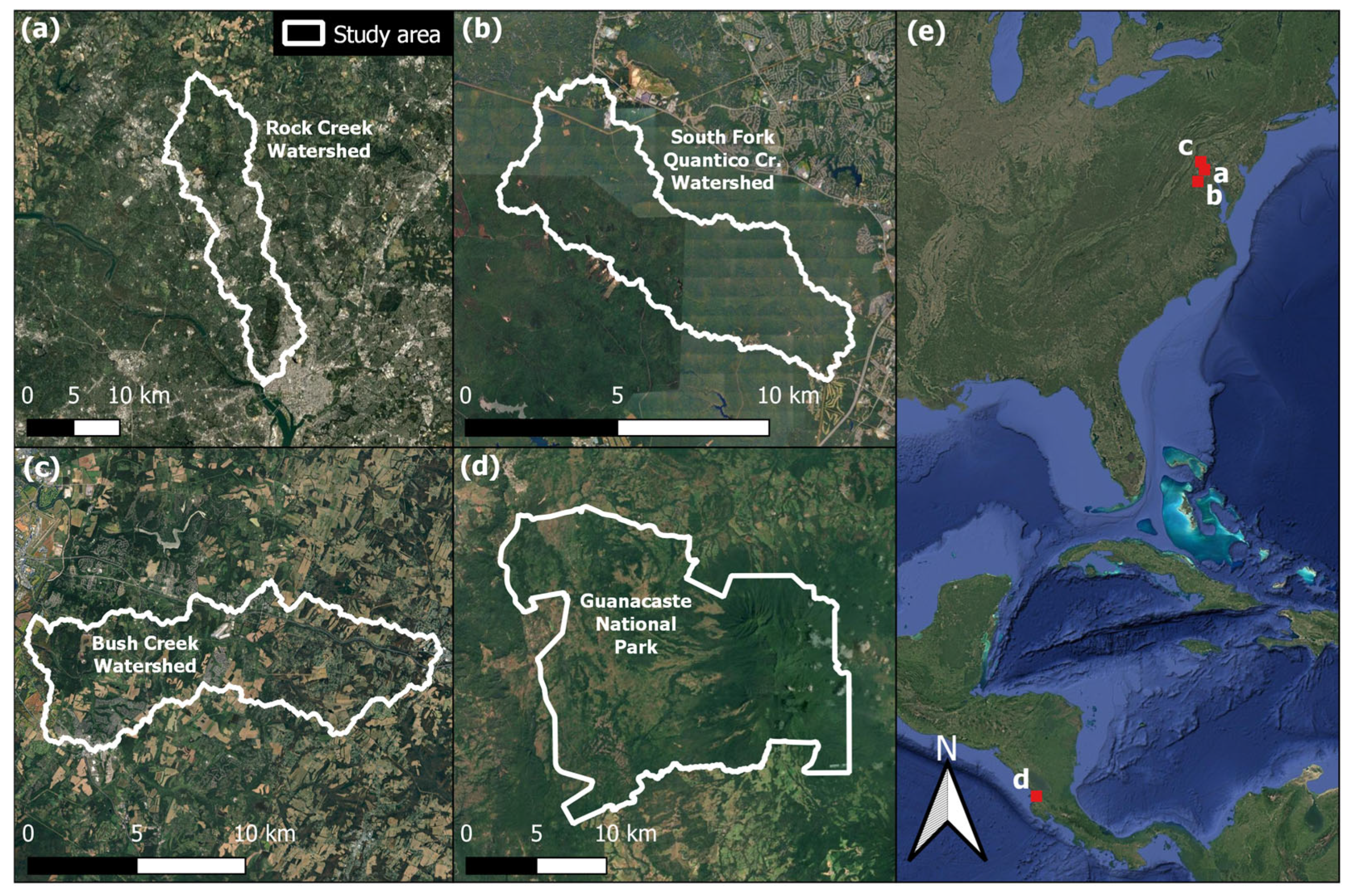
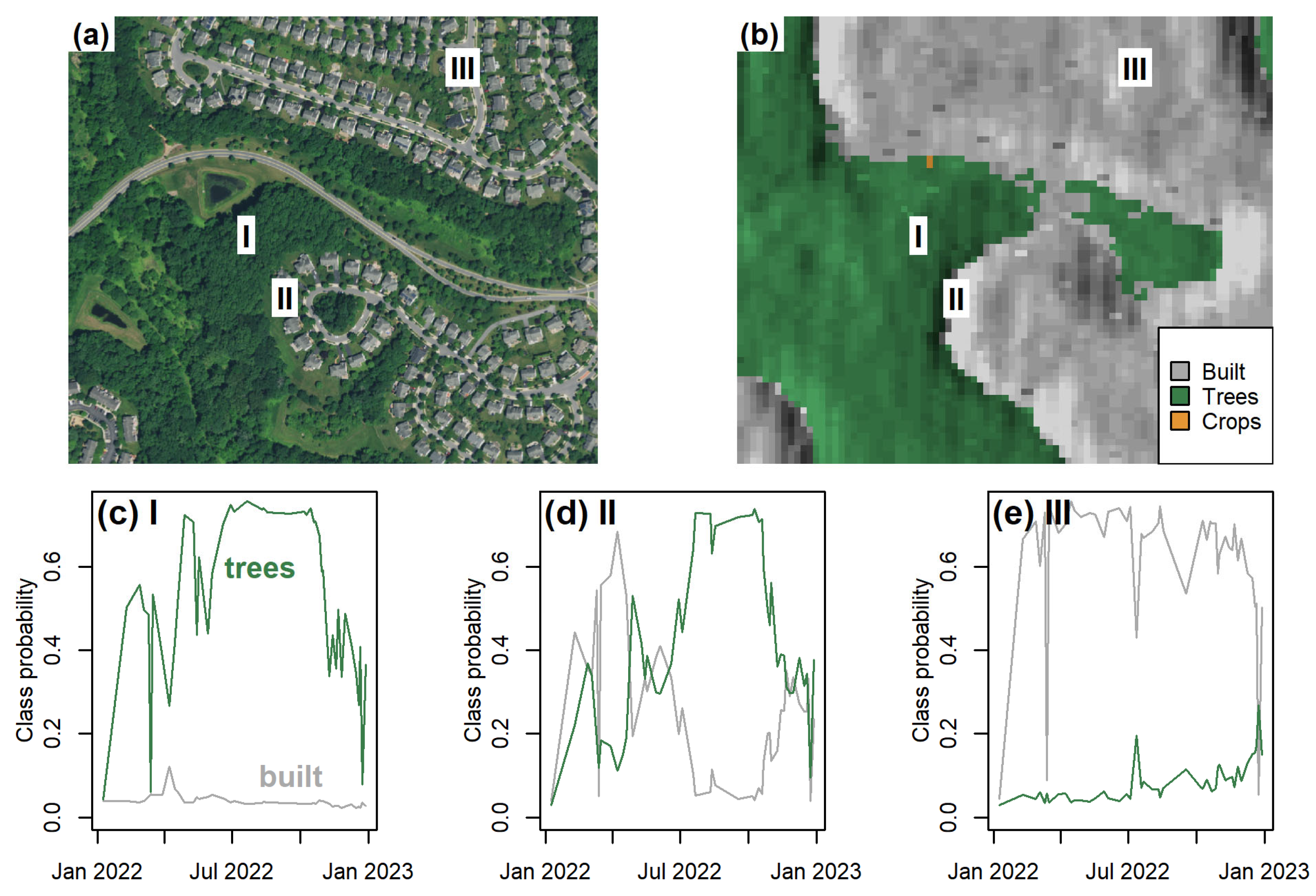
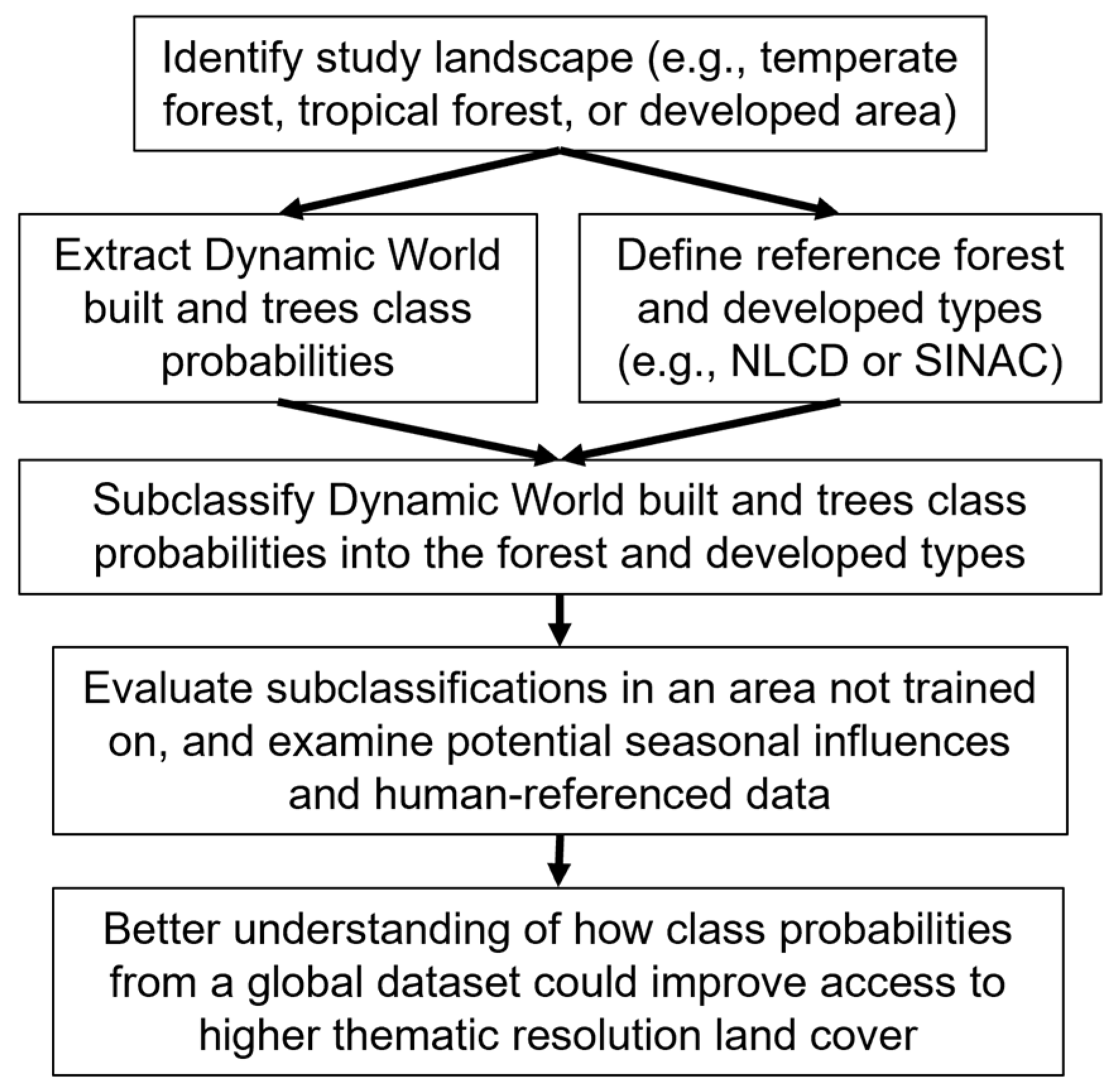
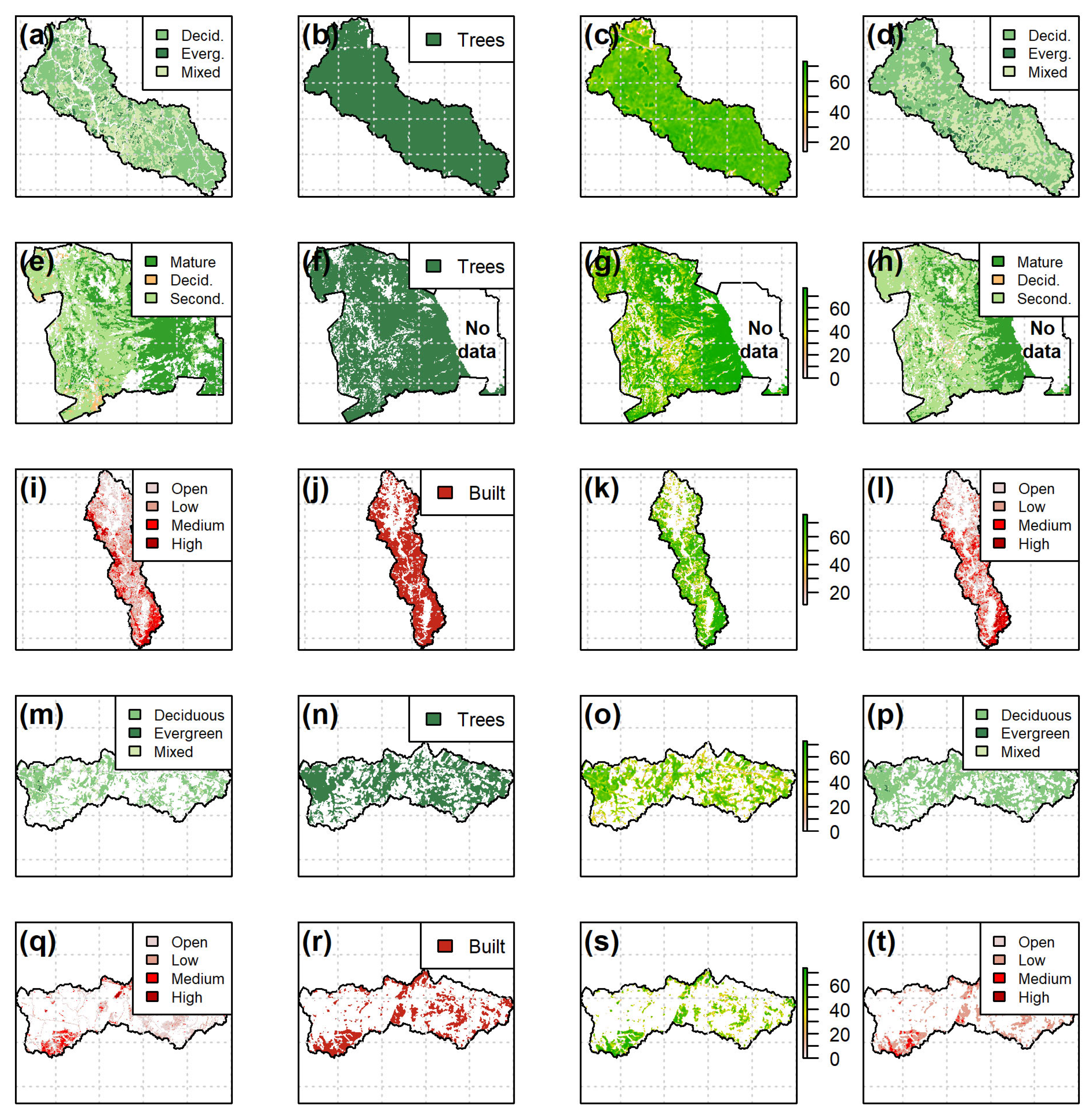
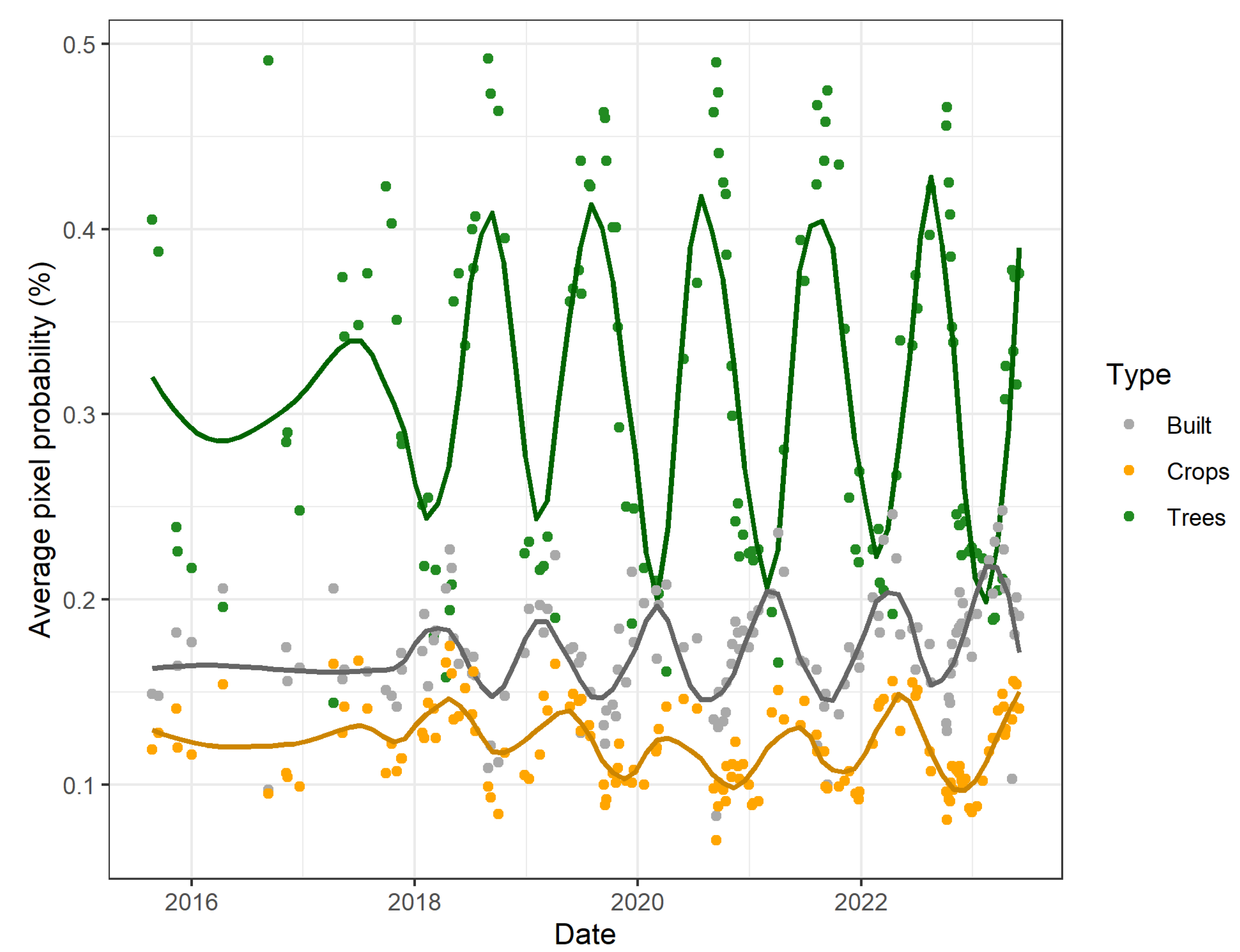
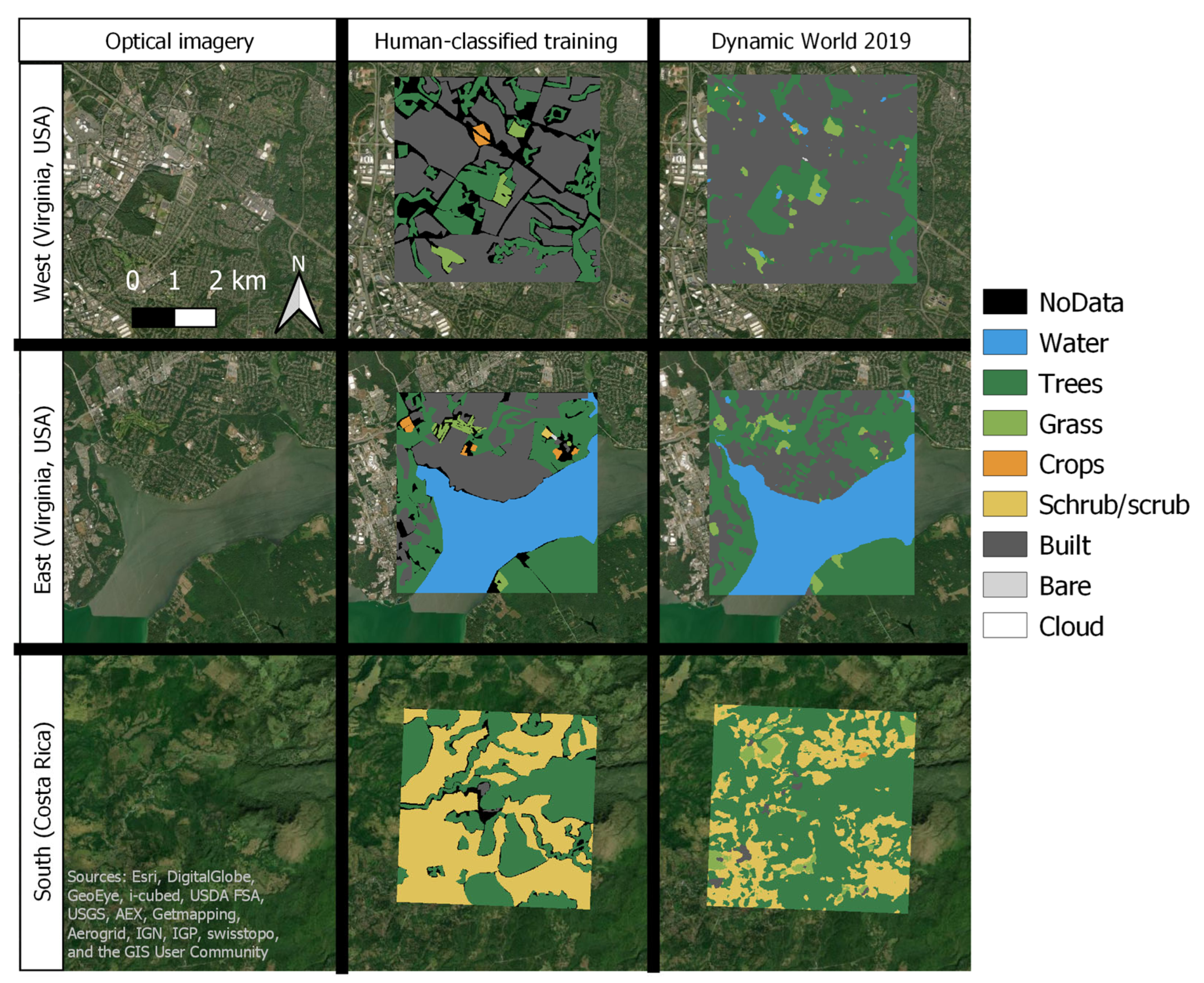
| Dataset | Spatial Resolution | Temporal Resolution | Classes Used | Span Used | Source |
|---|---|---|---|---|---|
| Dynamic World | 10 m | ~5 day | Built, trees | 2015–2023 | [23] |
| National Land Cover Database (NLCD) | 30 m | Annual or longer | Open space, low intensity, medium, intensity, and high-intensity developed; deciduous, evergreen, and mixed forest | 2019 | [8] |
| Costa Rica National System of Conservation Areas (SINAC) | 5 m | Annual or longer | Deciduous, secondary, and mature forest | 2019 | [39] |
| Dynamic World training dataset | 10 m | Image | Built, trees | 2019 | [40] |
| (a) South Fork Quantico Creek Watershed | |||||||
| Reference Data (NLCD) | |||||||
| Deciduous | Mixed | Evergreen | Total | User’s Acc. | |||
| Dyn. World class probabilities | Deciduous | 158,860 | 47,068 | 2252 | 208,180 | 76.31 | |
| Mixed | 66,364 | 66,077 | 8817 | 141,258 | 46.78 | ||
| Evergreen | 2977 | 11,902 | 11,169 | 26,048 | 42.88 | ||
| Total | 228,201 | 125,047 | 22,238 | 375,486 | NA | ||
| Prod’s Acc. | 69.61 | 52.84 | 50.22 | NA | OA: 62.88 | ||
| (b) Guanacaste National Park | |||||||
| Reference Data (SINAC) | |||||||
| Deciduous | Secondary | Mature | Total | User’s Acc. | |||
| Dyn. World class probabilities | Deciduous | 1575 | 40,308 | 782 | 42,665 | 3.69 | |
| Secondary | 43,338 | 983,435 | 192,831 | 1,219,604 | 80.64 | ||
| Mature | 14 | 113,094 | 563,075 | 676,183 | 83.27 | ||
| Total | 44,927 | 1,136,837 | 756,688 | 1,938,452 | NA | ||
| Prod’s Acc. | 3.51 | 86.51 | 74.41 | NA | OA: 79.86 | ||
| (c) Rock Creek Watershed | |||||||
| Reference Data (NLCD) | |||||||
| Open Space | Low | Medium | High | Total | User’s Acc. | ||
| Dyn. World class probabilities | Open space | 182,777 | 109,144 | 32,818 | 9787 | 334,526 | 54.64 |
| Low | 133,273 | 241,728 | 93,835 | 41,247 | 510,083 | 47.39 | |
| Medium | 25,282 | 123,437 | 102,826 | 50,898 | 302,443 | 34 | |
| High | 2859 | 26,189 | 49,543 | 19,910 | 98,501 | 20.21 | |
| Total | 344,191 | 500,498 | 279,022 | 121,842 | 1245,553 | NA | |
| Prod’s Acc. | 53.1 | 48.3 | 36.85 | 16.34 | NA | OA: 43.94 | |
| (d) Bush Creek Watershed Forest | |||||||
| Reference Data (NLCD) | |||||||
| Deciduous | Mixed | Evergreen | Total | User’s Acc. | |||
| Dyn. World class probabilities | Deciduous | 348,631 | 36,677 | 1212 | 386,520 | 90.2 | |
| Mixed | 21,852 | 4,220 | 1321 | 27,393 | 15.41 | ||
| Evergreen | 347 | 879 | 2365 | 3591 | 65.86 | ||
| Total | 370,830 | 41,776 | 4898 | 417,504 | NA | ||
| Prod’s Acc. | 94.01 | 10.1 | 48.29 | NA | OA: 85.08 | ||
| (e) Bush Creek Watershed Developed | |||||||
| Reference Data (NLCD) | |||||||
| Open Space | Low | Medium | High | Total | User’s Acc. | ||
| Dyn. World class probabilities | Open space | 83,186 | 34,305 | 13,122 | 2745 | 133,358 | 62.38 |
| Low | 27,534 | 29,600 | 20,299 | 3601 | 81,034 | 36.53 | |
| Medium | 2406 | 6818 | 14,523 | 3379 | 27,126 | 53.54 | |
| High | 68 | 411 | 1228 | 629 | 2336 | 26.93 | |
| Total | 113,194 | 71,134 | 49,172 | 10,354 | 243,854 | NA | |
| Prod’s Acc. | 73.49 | 41.61 | 29.54 | 6.07 | NA | OA: 52.46 | |
| (a) S.F. Quantico Creek Watershed | ||
| Class | NLCD (%) | DW (%) |
| Evergreen | 5.1 | 6.2 |
| Mixed | 28.8 | 35.4 |
| Deciduous | 52.5 | 57 |
| All forest | 86.3 | 98.6 |
| (b) Guanacaste National Park | ||
| Class | SINAC (%) | DW (%) |
| Deciduous | 2.3 | 2.5 |
| Mature | 28.6 | 27.5 |
| Secondary | 48.3 | 54.4 |
| All forest | 79.2 | 84.4 |
| (c) Rock Creek Watershed | ||
| Class | NLCD (%) | DW (%) |
| High | 6.2 | 4.9 |
| Med | 14.4 | 15.2 |
| Low | 26.6 | 26.1 |
| Open | 26.6 | 19.3 |
| All developed | 73.7 | 65.6 |
| (d) Bush Creek Watershed Forest | ||
| Class | NLCD (%) | DW (%) |
| Evergreen | 0.4 | 0.3 |
| Mixed | 3.3 | 2.4 |
| Deciduous | 27.9 | 47.5 |
| All forest | 31.5 | 50.2 |
| (e) Bush Creek Watershed Developed | ||
| Class | NLCD (%) | DW (%) |
| High | 0.8 | 0.2 |
| Med | 4.2 | 2.2 |
| Low | 7.4 | 7.3 |
| Open | 17.5 | 14.2 |
| All developed | 29.8 | 24 |
Disclaimer/Publisher’s Note: The statements, opinions and data contained in all publications are solely those of the individual author(s) and contributor(s) and not of MDPI and/or the editor(s). MDPI and/or the editor(s) disclaim responsibility for any injury to people or property resulting from any ideas, methods, instructions or products referred to in the content. |
© 2025 by the authors. Licensee MDPI, Basel, Switzerland. This article is an open access article distributed under the terms and conditions of the Creative Commons Attribution (CC BY) license (https://creativecommons.org/licenses/by/4.0/).
Share and Cite
Myers, D.T.; Oviedo-Vargas, D.; Daniels, M.; Aryal, Y. Increasing the Thematic Resolution for Trees and Built Area in a Global Land Cover Dataset Using Class Probabilities. Remote Sens. 2025, 17, 2570. https://doi.org/10.3390/rs17152570
Myers DT, Oviedo-Vargas D, Daniels M, Aryal Y. Increasing the Thematic Resolution for Trees and Built Area in a Global Land Cover Dataset Using Class Probabilities. Remote Sensing. 2025; 17(15):2570. https://doi.org/10.3390/rs17152570
Chicago/Turabian StyleMyers, Daniel T., Diana Oviedo-Vargas, Melinda Daniels, and Yog Aryal. 2025. "Increasing the Thematic Resolution for Trees and Built Area in a Global Land Cover Dataset Using Class Probabilities" Remote Sensing 17, no. 15: 2570. https://doi.org/10.3390/rs17152570
APA StyleMyers, D. T., Oviedo-Vargas, D., Daniels, M., & Aryal, Y. (2025). Increasing the Thematic Resolution for Trees and Built Area in a Global Land Cover Dataset Using Class Probabilities. Remote Sensing, 17(15), 2570. https://doi.org/10.3390/rs17152570








